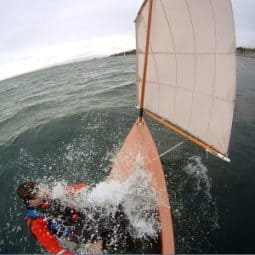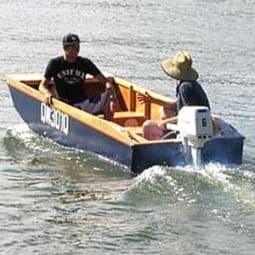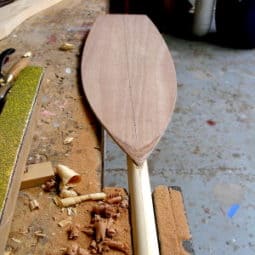Where a seam or boat chine is fibreglassed and the glass bubbles and will not sit flat or go around the corner – a simple trick for boatbuilding. This article shows how to make your own double bias tape.
A great DIY trick to solve many tricky boatbuilding problems.
- Great for difficult chines or rails on surfboards Sups or windsurfers
- Useful for complex 3D curves like the tips of centreboards and rudders or curved coamings or coachhouses
- In lightweight building can halve the glass weight as BOTH threads go across the hull join
Why Double Bias tape can go around a corner when normal glass tape cannot
Sometimes when glassing some small part of a boat, board or paddle the glass just won’t sit down flat and there are bubbles where the fibreglass won’t sit down flat.
The problem is that the curvatures of the piece require the glass to be more flexible.
Double Bias is a way of relaxing the curve by allowing the threads to go at a 45 degree angle across the curve.
It also allows the piece of glass to deform large amounts – it can be pulled long and narrow or wide and short.
Double Bias Tape is twice as strong as glass tape
Double bias tape is also useful in high strength applications as all the threads cross the join between the two pieces being taped.
Not essential for most craft but occasionally there is a high strength application. Long Double bias tapes are a cow to handle … so it really is better on small areas!

Using normal weave glass on a surface like this is difficult. There is an obvious curve from one side to another.
But also another more subtle curve from left to right.
And normally cut (0-90) glass only wants to do one of these curves.
A bias tape (+-45) makes each glass strand “think” that there is only a single curve.
Cutting normal glass cloth to make double bias tape for the tip of a centerboard or other curved area.
The tip is glassed with a piece of double bias cloth first. Double bias might sound a bit technical, but all it means is cutting out a piece to do the tip from the glass cloth you have bought, but instead of following the edges of the cloth the rectangular piece needs to be cut out at 45 degrees to the edges.

This means the threads in the piece will be at 45 degrees to the edges of the piece that you have cut out. It doesn’t need to be exactly 45 degrees if that won’t come out of the offcut from the cutting of the cloth for the body of the foils in the previous step.
This is by far the BEST way to cut out glass when it will have to curve two directions at once like on the rounded tips of the foils.
One of the weird things about double bias is that if you pull one end the tape gets longer – but a lot thinner – and vice versa – it is quite difficult to keep in shape so it is important to handle it carefully and cut out a piece bigger than you really need. Probably twice as wide and about 30 percent longer than you think you need.
The best tool for cutting normal fibreglass for small boats is a circular fabric knife
A carpet or stanley knife pulls the threads. The circular fabric knife cuts them where they lay!




















